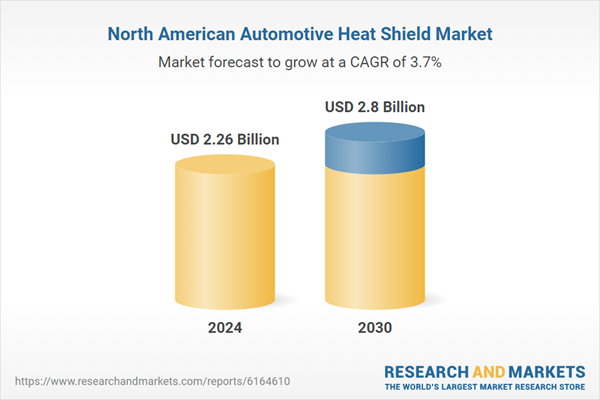Free Webex Call
The North America Automotive Heat Shield Market was valued at USD 2.26 Billion in 2024, and is expected to reach USD 2.80 Billion by 2030, rising at a CAGR of 3.67%. Speak directly to the analyst to clarify any post sales queries you may have.
10% Free customizationThis report comes with 10% free customization, enabling you to add data that meets your specific business needs.
Automotive heat shield demand is linked strongly to increasing engine downsizing, turbocharging, and electrification, which elevate under-hood temperatures and require more sophisticated thermal protection. According to the U.S. Department of Energy, around 60-70% of the fuel energy in conventional engines is lost as waste heat, creating an imperative for efficient heat shielding. Rising focus on vehicle NVH (Noise, Vibration, Harshness) refinement has prompted manufacturers to integrate heat shields that also act as acoustic barriers, reducing cabin noise and improving ride comfort. These developments reflect automakers’ pursuit of thermal, acoustic, and lightweight performance in a single solution.
Stringent fuel efficiency regulations have triggered extensive research into lightweight materials, including aluminum composites and ceramic fiber mats. According to the U.S. Department of Energy, reducing vehicle weight by 10% can improve fuel economy by 6-8%, stimulating adoption of advanced heat shielding solutions to meet both weight and thermal targets. Trends such as electric vehicle adoption further impact the market, as battery thermal management requires specialized heat shields to protect battery packs from external heat sources, ensuring safety and performance under diverse operating conditions.
Challenges remain significant due to fluctuating raw material prices and the complexity of balancing thermal, acoustic, and mechanical properties in modern vehicles. The U.S. Bureau of Labor Statistics reports ongoing volatility in metals like aluminum and stainless steel, directly impacting manufacturing costs. Integration difficulties also persist due to space constraints in engine compartments and exhaust systems, driving demand for thinner, high-performance solutions. Sustainability expectations from OEMs are reshaping product development as manufacturers invest in recyclable, low-emission heat shield materials to align with environmental goals.
Market Drivers
Engine Downsizing and Turbocharging
Smaller engines fitted with turbochargers deliver higher power while maintaining efficiency but generate increased heat requiring advanced shielding. As per the U.S. Department of Energy, turbocharged engines operate at temperatures exceeding 1,000°C in critical zones. These conditions demand high-performance heat shields to protect sensitive components and ensure regulatory compliance for thermal emissions. Automakers are prioritizing shields capable of withstanding intense heat and vibration while maintaining minimal weight impact. Innovations in multi-layer composite structures offer improved thermal insulation and durability, helping manage the complex thermal dynamics inside modern vehicles and supporting long-term reliability targets.Key Market Challenges
Fluctuating Raw Material Prices
Costs of aluminum, stainless steel, and composite fibers remain volatile, influencing manufacturing costs for heat shields. The U.S. Bureau of Labor Statistics tracks ongoing price shifts in industrial metals, affecting suppliers’ profit margins and supply chain stability. Rising input costs force manufacturers to seek alternative materials, develop cost-efficient designs, or absorb higher costs, impacting pricing for OEMs and consumers. This volatility complicates long-term planning, particularly for smaller suppliers lacking significant purchasing leverage. Sustainable sourcing and recycling initiatives partially offset cost risks, but market players continue navigating uncertainty in raw material pricing.Key Market Trends
Multi-Functional Heat Shields
Automotive heat shields increasingly combine thermal protection with acoustic damping and structural reinforcement. This trend reduces the number of parts in a vehicle, saving space and weight while improving performance. Composite materials and sandwich structures integrate metallic layers with noise-absorbing fibers, offering both heat reflection and sound insulation. Consumers demand quieter cabins and better thermal comfort, pushing automakers to adopt these dual-purpose solutions. As electrification advances, shields also protect sensitive electronics from both heat and electromagnetic interference, expanding their role beyond traditional applications and driving continuous innovation in product design and materials science.Key Market Players
- Autoneum Holding AG
- Dana Incorporated
- ElringKlinger AG
- Federal-Mogul Corporation
- Lydall Inc.
- MAHLE GmbH
- Morgan Advanced Materials
- Nichias Corporation
- Talbros Automotive Components Ltd.
- Tenneco Inc.
Report Scope:
In this report, the North America Automotive Heat Shield Market has been segmented into the following categories, in addition to the industry trends which have also been detailed below:North America Automotive Heat Shield Market, By Type:
- Engine Compartment
- Exhaust Compartment
- Others
North America Automotive Heat Shield Market, By Demand Category:
- OEM
- Aftermarket
North America Automotive Heat Shield Market, By Vehicle:
- Passenger Cars
- Commercial Vehicles
North America Automotive Heat Shield Market, By Country:
- United States
- Canada
- Mexico
Competitive Landscape
Company Profiles: Detailed analysis of the major companies present in the North America Automotive Heat Shield Market.Available Customizations:
North America Automotive Heat Shield Market report with the given market data, TechSci Research, offers customizations according to the company’s specific needs. The following customization options are available for the report.Company Information
- Detailed analysis and profiling of additional market players (up to five).
Table of Contents
1. Introduction
2. Research Methodology
3. Executive Summary
4. North America Automotive Heat Shield Market Outlook
5. United States Automotive Heat Shield Market Outlook
6. Mexico Automotive Heat Shield Market Outlook
7. Canada Automotive Heat Shield Market Outlook
8. Market Dynamics
12. Competitive Landscape
Companies Mentioned
- Autoneum Holding AG
- Dana Incorporated
- ElringKlinger AG
- Federal-Mogul Corporation
- Lydall Inc.
- MAHLE GmbH
- Morgan Advanced Materials
- Nichias Corporation
- Talbros Automotive Components Ltd.
- Tenneco Inc.
Table Information
| Report Attribute | Details |
|---|---|
| No. of Pages | 130 |
| Published | August 2025 |
| Forecast Period | 2024 - 2030 |
| Estimated Market Value ( USD | $ 2.26 Billion |
| Forecasted Market Value ( USD | $ 2.8 Billion |
| Compound Annual Growth Rate | 3.6% |
| Regions Covered | North America |
| No. of Companies Mentioned | 10 |









